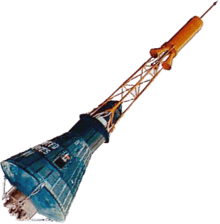Mercury-Atlas 2
 Launch of MA-2 | |||||
| Mission type | Test flight | ||||
|---|---|---|---|---|---|
| Operator | NASA | ||||
| Mission duration | 17 minutes, 56 seconds | ||||
| Distance travelled | 2,305 kilometres (1,432 mi) | ||||
| Apogee | 183 kilometres (114 mi) | ||||
| Spacecraft properties | |||||
| Spacecraft | Mercury No.6 | ||||
| Manufacturer | McDonnell Aircraft | ||||
| Launch mass | 1,154 kilograms (2,544 lb) | ||||
| Start of mission | |||||
| Launch date | February 21, 1961, 14:10 UTC | ||||
| Rocket | Atlas LV-3B 67-D | ||||
| Launch site | Cape Canaveral LC-14 | ||||
| End of mission | |||||
| Landing date | February 21, 1961, 14:28 UTC | ||||

| |||||
Mercury-Atlas 2 (MA-2) was launched unmanned on February 21, 1961 at 14:10 UTC, from Launch Complex 14 at Cape Canaveral, Florida.[1]
Test objectives for this flight were concerned with the ability of the spacecraft to withstand reentry under the temperature-critical abort conditions and with the capability of the Atlas to meet the proper injection conditions. Convair had promised to deliver thicker-skinned Atlas vehicles for subsequent flights, however Missile 67D was the last of the thin-skinned model and so it had to be modified for the Mercury mission, incorporating a stainless steel reinforcing band installed around the vehicle between stations 502 and 510. A thin sheet of asbestos was installed between the reinforcing band and the tank skin. This modification was installed as a precaution against the type of failure which had occurred on the previous MA-1 flight. The booster's flight path was also modified somewhat from Mercury-Atlas 1, being placed on a more shallow trajectory so as to reduce aerodynamic loads.
The Atlas lifted into a clear blue February sky quite different from the cloudy, foggy weather of the MA-1 flight. Everyone in the blockhouse waited nervously for the vehicle to pass through the critical Max Q zone. When it did so successfully, there was "enormous jubilation" from the launch team. MA-2 flew a successful suborbital mission that lasted 17 minutes 56 seconds. Altitude reached was 114 miles (183 km), speed, 13,227 mph (21,287 km/h). All test objectives were fully met, the only problems being a bit of propellant slosh. The capsule was recovered 1,432 miles (2305 km) downrange. Peak acceleration was 15.9 g (156 m/s²). Mass 1,154 kg.
Mercury spacecraft #6 and Atlas #67-D were used in the Mercury-Atlas 2 mission. The Mercury capsule is currently displayed at the Houston Museum of Natural Science, Houston, TX.[2]
References
- ↑ Loyd S. Swenson Jr., James M. Grimwood, Charles C. Alexander (1966). "This New Ocean: A History of Project Mercury - NASA SP-4201". NASA Special Publication-4201 in the NASA History Series. p. 4. Archived from the original on 2007-08-23. Retrieved 26 June 2013.
|chapter=ignored (help) - ↑ "Mercury spacecraft #6 display page on A Field Guide to American Spacecraft website".
![]() This article incorporates public domain material from websites or documents of the National Aeronautics and Space Administration.
This article incorporates public domain material from websites or documents of the National Aeronautics and Space Administration.
